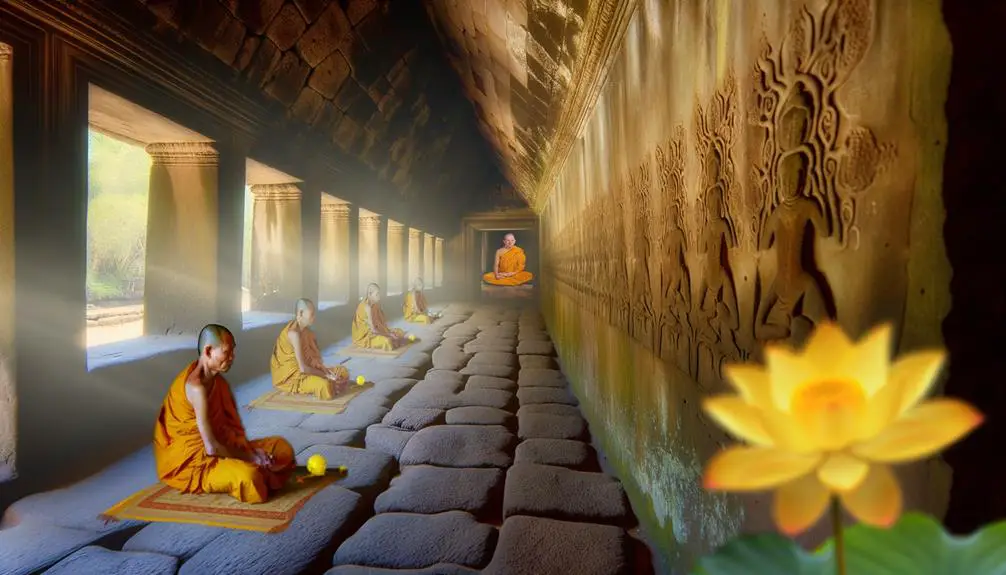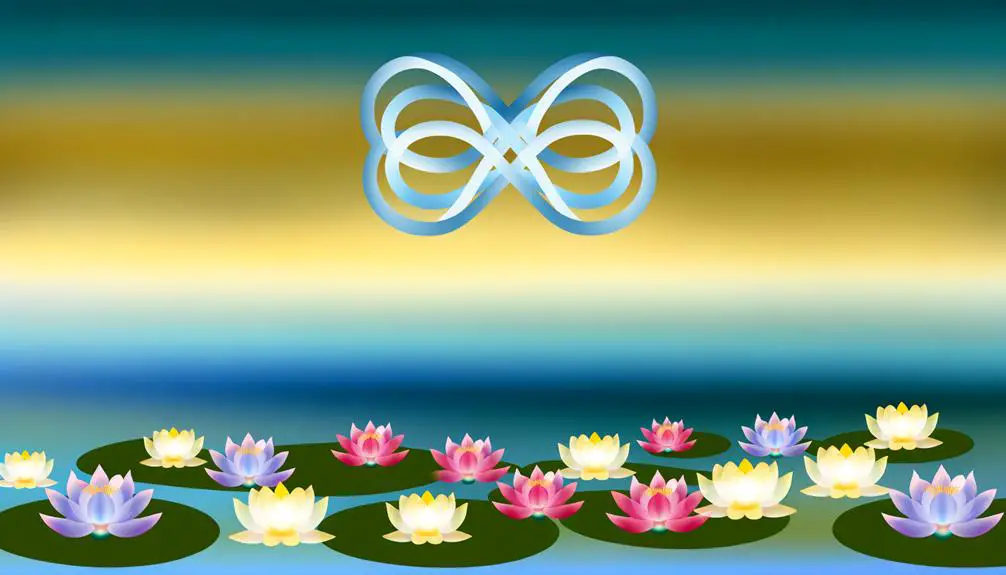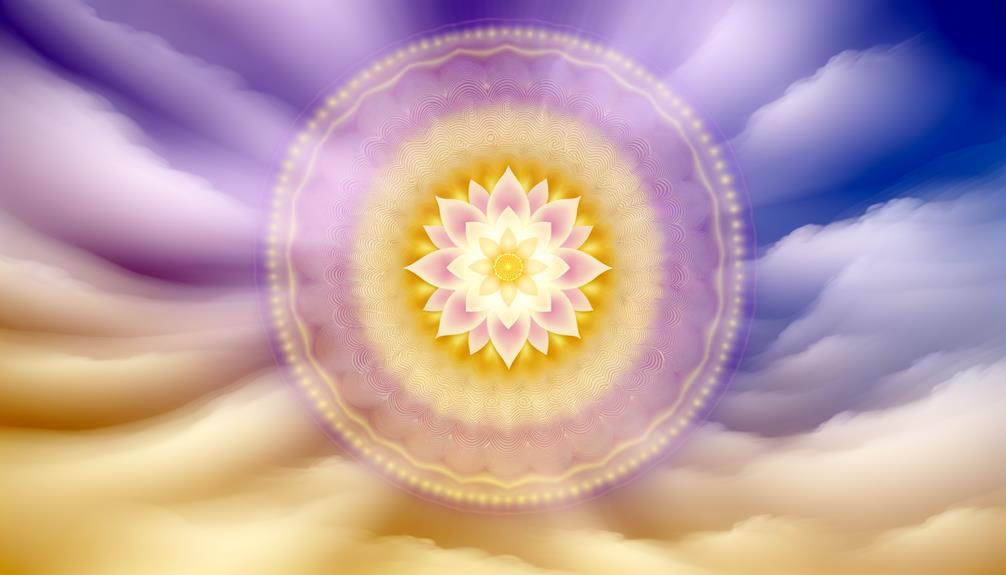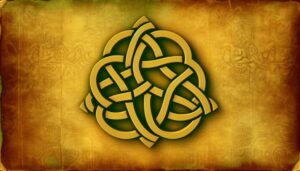What Is the Buddhist Symbol for Unconditional Love?
In Buddhism, the lotus flower and Bodhisattva Avalokiteshvara epitomize unconditional love. The lotus, emerging unsullied from muddy waters, symbolizes purity and spiritual awakening, indicative of transcending suffering.
Avalokiteshvara embodies boundless compassion and empathy, tirelessly aiding all beings to attain enlightenment. Together, these symbols encapsulate the essence of 'metta' (loving-kindness) and 'karuna' (compassion), foundational principles for spreading unconditional love.
Traditional and modern artistic representations leverage these symbols to convey resilience, interconnectedness, and spiritual clarity. Exploring further offers a richer understanding of how these symbols anchor the Buddhist path to universal compassion and love.

Key Takeaways
- The lotus flower symbolizes purity, spiritual awakening, and unconditional love.
- Avalokiteshvara represents infinite compassion and embodies the essence of unconditional love.
- The Heart Sutra emphasizes emptiness, fostering unconditional love through understanding interconnectedness.
- The Dharma Wheel reflects the Eightfold Path, promoting loving-kindness and compassion.
- The Endless Knot signifies interdependence and balance, essential for unconditional love.
Historical Background

The historical background of the Buddhist symbol for unconditional love traces back to early Buddhist teachings and iconography that emphasize compassion and loving-kindness as central tenets. Siddhartha Gautama, the historical Buddha, advocated for 'metta' (loving-kindness) and 'karuna' (compassion) as foundational virtues essential for achieving enlightenment.
These teachings were preserved in ancient texts like the Pali Canon and Mahayana sutras, which extensively explore the cultivation of boundless love. Early Buddhist art and symbols, including the lotus flower and the Bodhisattva Avalokiteshvara, visually represented these ideals. The lotus, for instance, symbolizes purity and spiritual awakening, while Avalokiteshvara embodies infinite compassion.
Consequently, historical Buddhist symbols for unconditional love are deeply rooted in doctrinal teachings and artistic expressions that underscore the importance of universal compassion.
Symbolic Interpretations
The symbolic interpretations of Buddhist symbols for unconditional love encompass a range of meaningful representations.
This section examines the significance of the lotus flower, the meaning of the endless knot, and the essence of the Heart Sutra, each contributing uniquely to the understanding of unconditional love in Buddhist philosophy.
Through these symbols, we gain insights into the profound and multifaceted nature of love as envisioned in Buddhist teachings.
Lotus Flower Significance
In Buddhist symbolism, the lotus flower represents purity, spiritual awakening, and the unfolding of the soul. The lotus emerges from murky waters, symbolizing the rise above worldly suffering and attachment. Its growth from mud to bloom signifies the journey from ignorance to enlightenment, illustrating the potential for all beings to attain spiritual clarity.
The various colors of the lotus also carry distinct meanings: the white lotus connotes spiritual perfection, the blue signifies wisdom, and the pink is often associated with the historical Buddha. This multifaceted symbolism underscores the lotus as an emblem of resilience and transcendence, capturing the essence of the Buddhist path to enlightenment and the inherent purity of the human spirit.
Endless Knot Meaning
Representing the interweaving of wisdom and compassion, the Endless Knot is a profound symbol in Buddhism, embodying the interconnectedness of all phenomena and the eternal cycle of life.
This intricate geometric pattern signifies the interplay between cause and effect, illustrating the principle of dependent origination where all events and entities are interdependent.
The knot's continuous loops suggest that existence is an unbroken cycle, devoid of a definitive beginning or end, consequently symbolizing samsara, the cycle of birth, death, and rebirth.
Additionally, the Endless Knot represents the union of wisdom (prajna) and method (upaya) in the path to enlightenment. Its symmetrical design underscores the balance and harmony essential to spiritual growth and the realization of Nirvana.
Heart Sutra Essence
Central to Mahayana Buddhism, the Heart Sutra's essence lies in its profound teachings on the nature of emptiness and the interdependent origination of all phenomena.
Emptiness, or 'Śūnyatā,' conveys that all forms, feelings, perceptions, mental formations, and consciousness are devoid of inherent existence. This realization fosters the understanding that all entities are interconnected and transient.
Symbolically, the Heart Sutra represents the dissolution of dualistic thinking, advocating for a non-discriminatory outlook that underpins unconditional love. It transcends egoistic attachments, fostering compassion and wisdom by recognizing the shared essence of all beings.
Consequently, the Heart Sutra serves as a potent reminder that true love arises from acknowledging and embracing the interconnected, empty nature of existence.
Artistic Representations

In examining the artistic representations of the Buddhist symbol for unconditional love, it is essential to contemplate both traditional Buddhist symbols and their evolution in modern artistic interpretations.
The adaptation of these symbols in contemporary art further exemplifies their enduring relevance and versatility. This analysis will explore how traditional iconography has been reimagined to convey universal themes of compassion and love.
Traditional Buddhist Symbols
Traditional Buddhist symbols encompass a wide array of artistic representations that convey profound spiritual principles and philosophical teachings. Among the most revered is the lotus flower, symbolizing purity and enlightenment, emerging unstained from the muddy waters of existence.
The Dharma Wheel, or Dharmachakra, illustrates the Eightfold Path leading to liberation. The Endless Knot signifies the interdependence of all phenomena, reflecting the interconnectedness essential to Buddhist thought.
The Bodhi Tree, under which Siddhartha Gautama attained enlightenment, represents wisdom and the potential for enlightenment in every being. Each symbol serves as a visual and contemplative tool, guiding practitioners towards deeper understanding and embodying core tenets of Buddhism, thereby enriching the spiritual journey.
Modern Artistic Interpretations
Modern artistic interpretations of Buddhist symbols have evolved to embody contemporary aesthetics while preserving the essence of their spiritual significance. Artists today often integrate traditional motifs with modern materials and techniques, resulting in a dynamic fusion that appeals to contemporary sensibilities.
For instance, the use of minimalist design elements can distill the symbol to its core message, making it accessible to a broader audience. Digital artistry also plays a significant role, allowing for intricate, scalable designs that can be disseminated globally.
Despite these modern adaptations, the underlying themes of compassion, mindfulness, and unconditional love remain intact. This balance between innovation and tradition safeguards that the symbols continue to resonate deeply within diverse cultural and temporal contexts.
Symbolism in Contemporary Art
Embracing both historical reverence and modern innovation, contemporary art representations of Buddhist symbols offer a nuanced exploration of their spiritual and cultural significance.
Artists adeptly blend traditional imagery, such as the lotus and the endless knot, with avant-garde techniques, creating pieces that resonate in modern contexts.
These representations often serve dual purposes: as aesthetic objects and as conduits for deeper philosophical reflection.
By integrating elements like abstraction and multimedia, contemporary artists expand the interpretive possibilities of these symbols, allowing them to transcend cultural and temporal boundaries.
This dynamic interplay between the old and new fosters a richer, more inclusive understanding of Buddhist concepts, particularly the profound notion of unconditional love.
Cultural Significance
The cultural significance of the Buddhist symbol for unconditional love lies in its profound representation of compassion, boundless empathy, and interconnectedness within the framework of Buddhist philosophy. This symbol transcends mere artistic expression, embedding itself deeply within various cultural practices and societal norms. It acts as a moral compass, guiding individuals and communities toward a harmonious coexistence. The table below highlights key cultural aspects influenced by this symbol:
| Aspect | Influence |
|---|---|
| Art and Literature | Themes of compassion and unity |
| Social Practices | Emphasis on empathy and collective well-being |
| Rituals | Integrative ceremonies promoting interconnectedness |
| Ethical Teachings | Foundational principles of love and compassion |
| Education | Curriculum incorporating moral and ethical teachings |
The pervasive influence underscores its role in shaping cultural ethos and values.
Spiritual Teachings

Rooted in the core tenets of Buddhism, the symbol for unconditional love encapsulates profound spiritual teachings that emphasize the cultivation of boundless compassion and selfless love.
Central to these teachings is the concept of 'metta' or loving-kindness, which advocates for an all-encompassing benevolence towards all sentient beings, transcending personal attachments and biases. This ethos is further reinforced by the practice of 'karuna' or compassion, which encourages empathetic engagement with the suffering of others.
Combined, these principles foster a mindset wherein one's actions and thoughts are directed towards the well-being of all. The symbol, therefore, serves as a visual and philosophical reminder of the intrinsic value of nurturing love and empathy within the context of spiritual growth and ethical behavior.
Modern Applications
In contemporary society, the Buddhist symbol for unconditional love finds resonance in various fields, including psychology, social work, and conflict resolution. It is employed to promote empathy, compassion, and holistic well-being.
In psychology, therapists integrate this symbol to help clients cultivate self-compassion and emotional resilience. Social workers utilize it to foster strong, supportive relationships within communities, thereby enhancing social cohesion.
In conflict resolution, the symbol serves as a tool to encourage understanding and reconciliation among disputing parties. By embodying principles of unconditional love, practitioners in these fields aim to create environments that support mental health, social harmony, and constructive dialogue.
Showcasing the symbol's enduring relevance and transformative potential in modern contexts.
Personal Reflections

Reflecting on the Buddhist symbol for unconditional love invites an examination of its profound impact on individual development and interpersonal relationships. This symbol encourages a deep sense of empathy and compassion, fostering personal growth and harmonious connections.
By internalizing this symbol, individuals can experience:
- Inner Peace: Embracing unconditional love reduces internal conflicts and cultivates mental tranquility.
- Strengthened Bonds: Relationships are enhanced through genuine, selfless love, promoting mutual respect and understanding.
- Resilience: Unconditional love equips individuals to navigate adversities with grace and fortitude.
Analytically, the symbol functions as a transformative tool, guiding individuals toward emotional intelligence and altruism. Its integration into daily life underscores the importance of love as a universal, unifying force, essential for personal and collective well-being.
Conclusion
The Buddhist symbol for unconditional love, often represented by the lotus flower, juxtaposes historical depth with contemporary relevance. It embodies purity and spiritual awakening, transcending mere artistic representation to encompass profound cultural and spiritual significance.
While ancient teachings emphasize its role in fostering compassion and interconnectedness, modern interpretations apply these timeless principles to diverse contexts. This synthesis of tradition and modernity underscores the enduring power of the symbol in promoting universal love and harmony.






